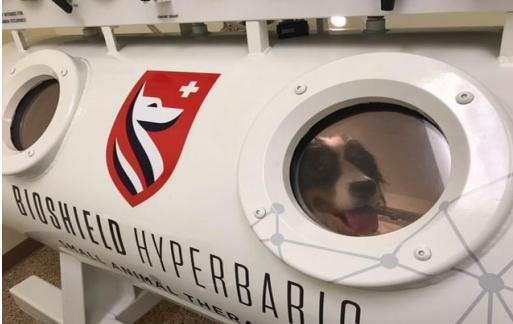 Picture courtesy of Randy Gaines
Picture courtesy of Randy Gaines
Hyperbaric therapy has become popular for people to help with healing. What most people don’t know, is that it is available for animals as well, and being used more and more as a therapy along with traditional medication.
What is Hyperbaric Oxygen Therapy?
Divers were the first users of Hyperbaric Oxygen Therapy (HBOT) for decompression sickness and embolisms. If a diver had bubbles of gas build up in his tissues, it could be deadly. HBOT was used to reduce the size of those bubbles as well as the nitrogen from the bubbles. It also kept blood moving to the tissues, which is important because if tissues don’t have oxygen, they die. When the bubbles were gone, the oxygen pressure was slowly reduced back to normal levels.
The treatment has evolved, so patients who have been exposed to smoke inhalation or carbon monoxide, have severe wound infections that causes tissues to die, have anemia, or severe burns are often put in hyperbaric chambers.
If we break down the word “hyperbaric”, it has Greek roots. “Hyper” means more, and “baric” is pressure. What HBOT does is pushes oxygen to a level that is higher than atmospheric pressure—up to three times more than normal. This oxygenates tissues, fluids, and organs more than red blood cells can do on their own. More oxygen in the blood decreases inflammation and promotes healing.
What is HBOT Used for With Pets?
There are several conditions that can benefit from HBOT:
• Burns
• Wounds that won’t heal
• Arthritis
• Anemia
• Pancreatitis
• Spinal cord injuries
• Stroke
• Osteomyelitis
• Smoke inhalation
• Snake bites
• Muscle trauma
However, if your pet has a high fever, a heart problem, respiratory infection, or malignant disease, HBOT may not be recommended.
Side Effects
There are very few side effects with HBOT, mostly because of the care taken in determining which pets are most suited for the treatment. Also, there are considerations for proper dosing, how often the pet is in the chamber, and how long they’re in the chamber. Compression and decompression are closely monitored.
How Often Is HBOT Used on a Pet?
Each treatment typically lasts one to two hours, and your pet may be placed in the chamber multiple times, depending on the diagnosis. Treatment will end when the doctor sees improvement.
Your pet will be able to lie comfortably inside, and most of them sleep. They are under constant surveillance because 100% oxygen can be dangerous. Pets are either wetted down with water before entering the hyperbaric chamber or lay on a static inhibitor ground plate. Their collars are also removed. This is to prevent their coat from accumulating static electricity, which could ignite and cause a fire.
Once the pet exits the chamber, they visibly feel better—they seem happier, perkier, and move with much more ease.
If you have questions about hyperbaric oxygen therapy and if it can help your pet, give Dr. Newman a call at 208-233-2844. She’s always happy to answer your questions!


